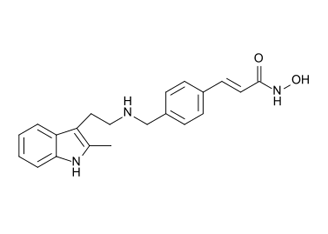Panobinostat Improves PFS in Relapsed, Refractory Multiple Myeloma
Treatment of relapsed or refractory multiple myeloma with the three-drug combination of panobinostat/bortezomib/dexamethasone resulted in a nearly 4-month improvement in progression-free survival compared to treatment with bortezomib/dexamethasone alone.
Chemical structure of panobinostat.

Treatment of relapsed or refractory multiple myeloma with the three-drug combination of panobinostat/bortezomib/dexamethasone resulted in a nearly 4-month improvement in progression-free survival compared with treatment with bortezomib/dexamethasone alone, according to the results of the PANORAMA 1 trial (abstract 8510) presented at the 2014 American Society of Clinical Oncology (ASCO) Annual Meeting.
Additionally, study presenter Paul G. Richardson, MD, of Dana-Farber Cancer Institute, said that an approximate twofold increase in the rate of complete response or near complete response was seen with the addition of panobinostat.
“We believe that panobinostat constitutes a significant advance in this field, especially in the patients with relapsed or relapsed and refractory disease,” Richardson said.
Panobinostat is an oral pan deacetylase inhibitor found to increase acetylation of proteins involved in multiple oncogenic pathways. In his presentation, Dr. Richardson pointed out that panobinostat targets HDAC6, which previous studies have shown is an important target in multiple myeloma.
Additionally, phase I and II studies had demonstrated robust responses when patients with relapsed or relapsed and refractory multiple myeloma were treated with a combination of panobinostat/dexamethasone/bortezomib.
The PANORAMA 1 study included 768 patients who were stratified by prior lines of therapy and randomly assigned to dexamethasone/bortezomib with or without panobinostat. The study included two phases. The first phase was eight 21-day cycles for 6 months. Patients who derived clinical benefit moved on to the second phase, which was four 42-days cycles for 6 months. The median age of patients was 63 years. About 50% of patients received two or more prior therapies.
Patients assigned panobinostat had a significant increase in median progression-free survival compared with placebo (HR = 0.63; 95% CI, 0.52-0.76; P < .0001). The median progression-free survival was 12 months in the panobinostat arm compared with 8.1 months for placebo.
Preplanned subgroup analyses also revealed some interesting trends, Richardson said. First, the effect of panobinostat was consistent regardless of race, sex, age, or clinical stage.
“What was interesting to us was in the small number of patients with poor-risk cytogenetics we did see effect but we recognize that the confidence intervals are broad,” Richardson said. “What is interesting about this though is it resonates with observations in earlier studies where we have seen a particularly interesting signal in high-risk cytogenetics.”
Results of an interim analysis showed no significant difference in overall survival between the two study arms. However, Richardson pointed out a trend toward better survival with the there-drug arm. Final overall analysis will be done after 415 events have been reached.
A significant different in complete response and near complete response was also revealed with the rate nearly double in patients assigned panobinostat (27.6% vs 15.7%; P = .00006).
Patients assigned panobinostat had a high rate of all grades of diarrhea and fatigue. Richardson noted that with dose reduction and supportive care, these symptoms were relatively well managed. Discontinuation due to diarrhea was 4.5% and due to fatigue was 2.9% among patients assigned panobinostat.
Discontinuation due to thrombocytopenia was also low (panobinostat, 1.6% vs placebo, 0.5%). There was a noteworthy difference in the occurrence of grade 3/4 thrombocytopenia between the investigational arm (67.4%) and the placebo arm (31.4%).
Thirty deaths in the panobinostat arm occurred and 18 in the placebo arm occurred. The researchers classified 11 of the deaths in the panobinostat arm and 7 of the deaths in the placebo arm as possibly related to study drugs.
Newsletter
Stay up to date on recent advances in the multidisciplinary approach to cancer.